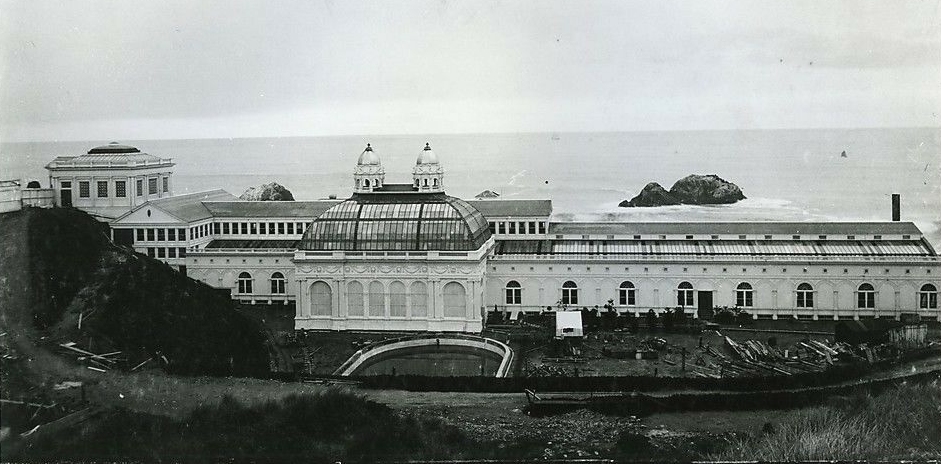|
Playland-Not-At-The-Beach
Playland-Not-At-The-Beach was a non-profit, family-oriented museum in El Cerrito, California celebrating America's bygone amusements, operated entirely by volunteers. The museum's 25 exhibits have specific emphasis on the attractions that once existed at Playland at the Beach and the Sutro Baths & Museum. Included are numerous artifacts from the original Whitney's Playland at the Beach, including the giant clown's blue hat from the top of the Playland Funhouse, and Walking Charley, one of the original hand carved life-size wooden characters from the terrace above Laughing Sal in the front window of the Fun House. Thousands of historical items are present, from cases of never-opened books of Playland tickets to original signage, parts of rides and games, rare photographs, employee uniforms, and prizes from the Playland arcade games. Additionally, there are over 30 pinball games, carnival skill games, dioramas celebrating Halloween and the Yuletide season, and miniature circuse ... [...More Info...] [...Related Items...] OR: [Wikipedia] [Google] [Baidu] |
Playland (San Francisco)
Playland (also known as Playland-at-the-Beach and Whitney's Playland, beginning in 1928—some say 1926--) was a seaside amusement park located next to Ocean Beach, San Francisco, California, Ocean Beach, in the Richmond District, San Francisco, Richmond District at the western edge of San Francisco, California, along Great Highway, bounded by Balboa and Fulton streets. It began as a collection of amusement rides and concessions in the late 19th century, and was preceded by Chutes at the Beach, opened in 1921. Playland closed Labor Day weekend in 1972. History Before Playland The area that was Playland began as a 19th-century squatter's settlement, "Mooneysville-by-the-Sea".Beldner, RaPublic Art: Playland Revisited. Access 7 August 2007. By 1884, a steam railroad was in place to bring people to the first amusement ride at the City’s ocean side — a "Gravity Railroad" roller coaster, and to the Ocean Beach Pavilion for concerts and dancing. By 1890, Tram, trolley lin ... [...More Info...] [...Related Items...] OR: [Wikipedia] [Google] [Baidu] |
Marcks Family Miniature Circus
The Marcks Family Miniature Circus is a miniature representation of the Sells Floto Circus of the 1930s. It was conceived and originated by Isaac Marcks and hand carved over the span of 50 years by him and his son Donald Marcks, publisher of the popular weekly publication ''Circus Report''. The circus is built to a scale of one-half inch equals one foot and consists of multiple tents and scores of wagonsand people, all hand carved. All figures are exact copies of the Sells Floto Circus as it appeared on a particular date, June 30, 1930. With over 300,000 pieces in the collection, the miniature circus main tent stands 25 inches tall and is 5 feet wide and 11 feet long. Until 2018 it was on display at Playland-Not-At-The-Beach. When Playland-Not-At-The-Beach Playland-Not-At-The-Beach was a non-profit, family-oriented museum in El Cerrito, California celebrating America's bygone amusements, operated entirely by volunteers. The museum's 25 exhibits have specific emphasis on t ... [...More Info...] [...Related Items...] OR: [Wikipedia] [Google] [Baidu] |
Laffing Sal
Laffing Sal is one of several animatronic characters that were built primarily to attract carnival and amusement park patrons to funhouses and dark rides throughout the United States. Its movements were accompanied by a raucous laugh that sometimes frightened small children and annoyed adults.''History of Laffing Sal'' , . Accessed 10 August 2007. History Laffing Sal (sometimes incorrectly called "Laughing Sal") was produced by the (PTC) of[...More Info...] [...Related Items...] OR: [Wikipedia] [Google] [Baidu] |
El Cerrito, Contra Costa County, California
El Cerrito (Spanish for "The Little Hill") is a city in Contra Costa County, California, United States, and forms part of the San Francisco Bay Area. It has a population of 25,962 according to the 2020 census. El Cerrito was founded by refugees from the 1906 San Francisco earthquake. It was incorporated in 1917 as a village with 1,500 residents. As of the census in 2000, there were 23,171 people, 10,208 households and 5,971 families in the city. History El Cerrito was founded by refugees from the 1906 San Francisco earthquake. They settled in what was then Don Víctor Castro's Rancho San Pablo, and adjacent to the ranch owned by the family of Luís María Peralta, the Rancho San Antonio.Contra Costa/Alameda County Line , Mervin Belfils/El Cerrito Historical Society, October 1975/June 2006, retrieved 2007-08 ... [...More Info...] [...Related Items...] OR: [Wikipedia] [Google] [Baidu] |
California
California is a U.S. state, state in the Western United States, located along the West Coast of the United States, Pacific Coast. With nearly 39.2million residents across a total area of approximately , it is the List of states and territories of the United States by population, most populous U.S. state and the List of U.S. states and territories by area, 3rd largest by area. It is also the most populated Administrative division, subnational entity in North America and the 34th most populous in the world. The Greater Los Angeles area and the San Francisco Bay Area are the nation's second and fifth most populous Statistical area (United States), urban regions respectively, with the former having more than 18.7million residents and the latter having over 9.6million. Sacramento, California, Sacramento is the state's capital, while Los Angeles is the List of largest California cities by population, most populous city in the state and the List of United States cities by population, ... [...More Info...] [...Related Items...] OR: [Wikipedia] [Google] [Baidu] |
Sutro Baths
The Sutro Baths was a large, privately owned public saltwater swimming pool complex in the Lands End area of the Outer Richmond District in western San Francisco, California. Built in 1894, the Sutro Baths was located north of Ocean Beach, the Cliff House, Seal Rocks, and west of Sutro Heights Park. The structure burned down to its concrete foundation in June 1966; its ruins are located in the Golden Gate National Recreation Area and the Sutro Historic District. History On March 14, 1896, the Sutro Baths were opened to the public as the world's largest indoor swimming pool establishment. The baths were built on the western side of San Francisco by wealthy entrepreneur and former mayor of San Francisco (1894–1896) Adolph Sutro. The structure was situated in a small beach inlet below the Cliff House, also owned by Adolph Sutro at the time. Both the Cliff House and the former baths site are now a part of the Golden Gate National Recreation Area, operated by the Unite ... [...More Info...] [...Related Items...] OR: [Wikipedia] [Google] [Baidu] |
List Of Abandoned Amusement Parks
The following is a list of amusement parks and theme parks that have been closed, demolished, or abandoned: Africa Egypt * Luna Park, Cairo (1911–1915) Rwanda *Kigali Park, Rwanda South Africa * Ratanga Junction, Cape Town (1998-2018) Tanzania * Umoja Children's Park, Chake-Chake, Zanzibar Asia Mainland China *Children's Amusement Park, Seven Star Park, Guilin *Dolphin Bay Dream Water Park, Pingyang County * Grand World Scenic Park *Honey Lake Entertainment City, Shenzhen (1985–2011) * Minsk World (2000-2016) * Wonderland Amusement Park, Chenzhuang Village, Nankou Town, Changping District Hong Kong SAR * Kai Tak Amusement Park, New Kowloon (1965–1982) * Lai Chi Kok Amusement Park, Lai Chi Kok (1949–1997) *Luna Park, Hong Kong, North Point (1949–1954) * Tiger Balm Garden, Wan Chai (1935–1998) Indonesia *Kampung Gajah, Bandung (2010–2017) *Taman Remaja Surabaya, Surabaya (1971–2018) * Wonderia, Semarang (2006–2017) India * Appu Ghar, New Delhi ( ... [...More Info...] [...Related Items...] OR: [Wikipedia] [Google] [Baidu] |
Museums In Contra Costa County, California
A museum ( ; plural museums or, rarely, musea) is a building or institution that cares for and displays a collection of artifacts and other objects of artistic, cultural, historical, or scientific importance. Many public museums make these items available for public viewing through exhibits that may be permanent or temporary. The largest museums are located in major cities throughout the world, while thousands of local museums exist in smaller cities, towns, and rural areas. Museums have varying aims, ranging from the conservation and documentation of their collection, serving researchers and specialists, to catering to the general public. The goal of serving researchers is not only scientific, but intended to serve the general public. There are many types of museums, including art museums, natural history museums, science museums, war museums, and children's museums. According to the International Council of Museums (ICOM), there are more than 55,000 museums in 202 countries ... [...More Info...] [...Related Items...] OR: [Wikipedia] [Google] [Baidu] |
Amusement Museums In The United States
Amusement is the state of experiencing humorous and entertaining events or situations while the person or animal actively maintains the experience, and is associated with enjoyment, happiness, laughter and pleasure. It is an emotion with positive valence and high physiological arousal. Amusement is considered an " epistemological" emotion because humor occurs when one experiences a cognitive shift from one knowledge structure about a target to another, such as hearing the punchline of a joke. The pleasant surprise that happens from learning this new information leads to a state of amusement which people often express through smiling, laughter or chuckling. Current studies have not yet reached consensus on the exact purpose of amusement, though theories have been advanced in the fields of psychology, psychiatry, and sociology. In addition, the precise mechanism that causes a given element (image, sound, behavior, etc.) to be perceived as more or less 'amusing' than another sim ... [...More Info...] [...Related Items...] OR: [Wikipedia] [Google] [Baidu] |
History Museums In California
History (derived ) is the systematic study and the documentation of the human activity. The time period of event before the invention of writing systems is considered prehistory. "History" is an umbrella term comprising past events as well as the memory, discovery, collection, organization, presentation, and interpretation of these events. Historians seek knowledge of the past using historical sources such as written documents, oral accounts, art and material artifacts, and ecological markers. History is not complete and still has debatable mysteries. History is also an academic discipline which uses narrative to describe, examine, question, and analyze past events, and investigate their patterns of cause and effect. Historians often debate which narrative best explains an event, as well as the significance of different causes and effects. Historians also debate the nature of history as an end in itself, as well as its usefulness to give perspective on the problems of the p ... [...More Info...] [...Related Items...] OR: [Wikipedia] [Google] [Baidu] |
Circus Museums In The United States
A circus is a company of performers who put on diverse entertainment shows that may include clowns, acrobats, trained animals, trapeze acts, musicians, dancers, hoopers, tightrope walkers, jugglers, magicians, ventriloquists, and unicyclists as well as other object manipulation and stunt-oriented artists. The term ''circus'' also describes the performance which has followed various formats through its 250-year modern history. Although not the inventor of the medium, Philip Astley is credited as the father of the modern circus. In 1768, Astley, a skilled equestrian, began performing exhibitions of trick horse riding in an open field called Ha'Penny Hatch on the south side of the Thames River, England. In 1770, he hired acrobats, tightrope walkers, jugglers and a clown to fill in the pauses between the equestrian demonstrations and thus chanced on the format which was later named a "circus". Performances developed significantly over the next fifty years, with large-scale theatr ... [...More Info...] [...Related Items...] OR: [Wikipedia] [Google] [Baidu] |


.jpg)


.jpg)
